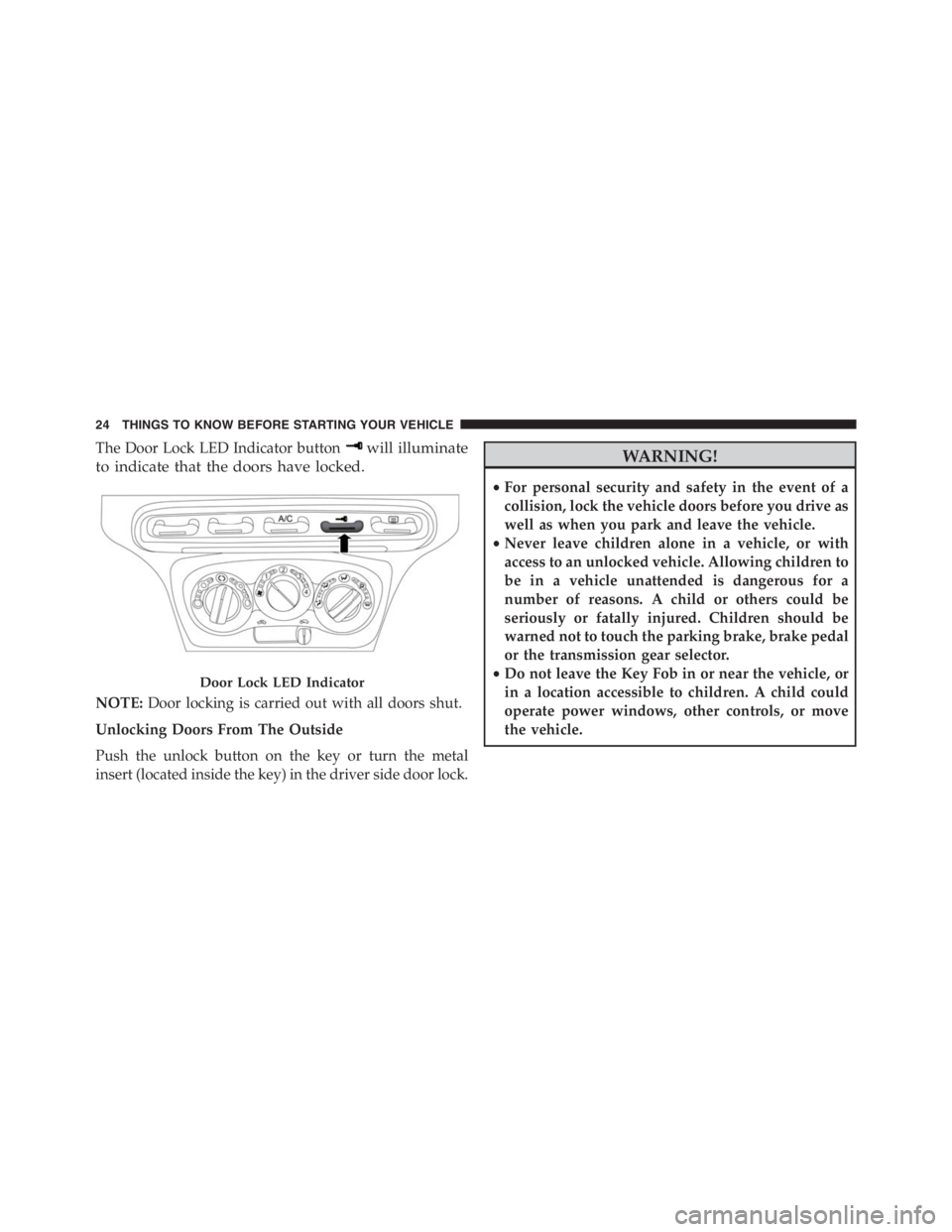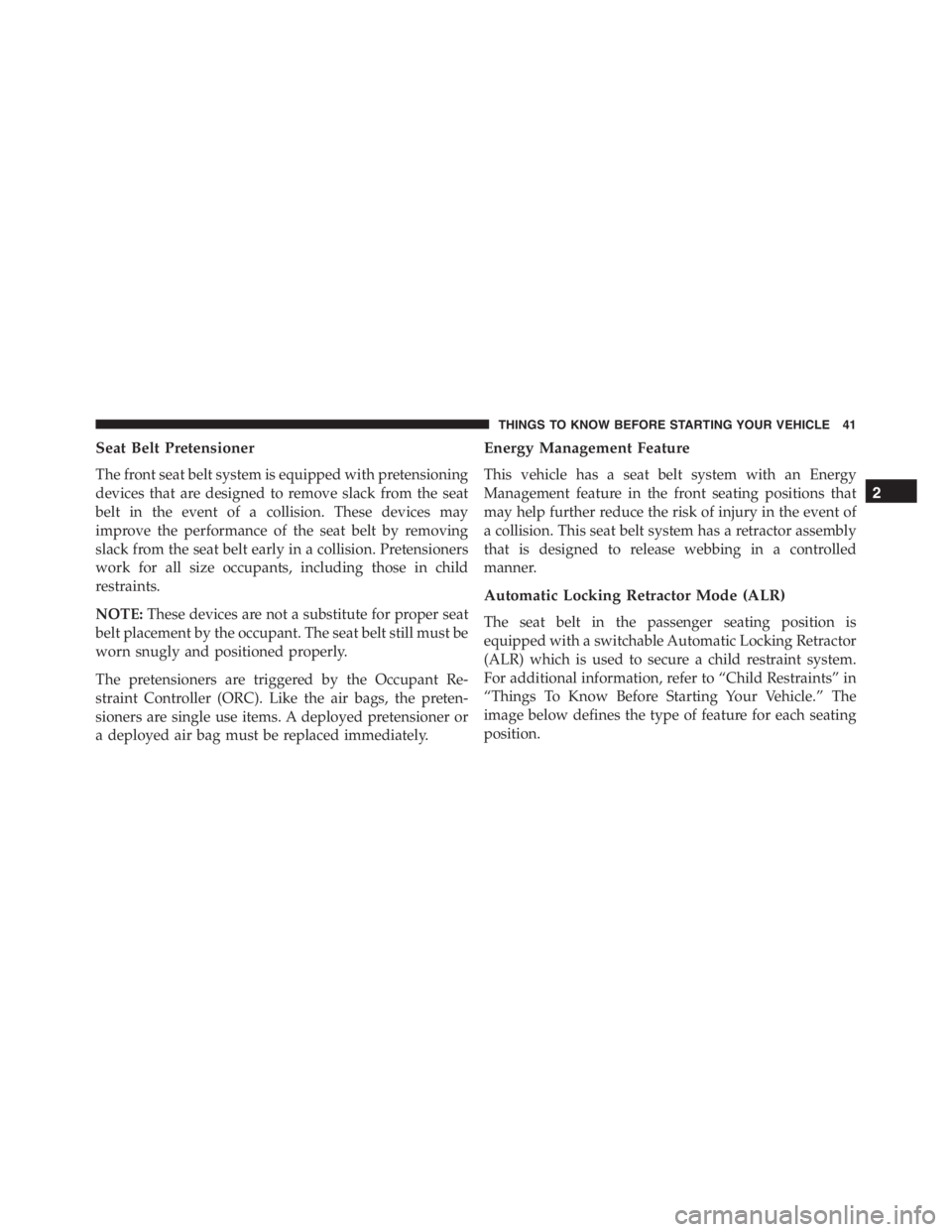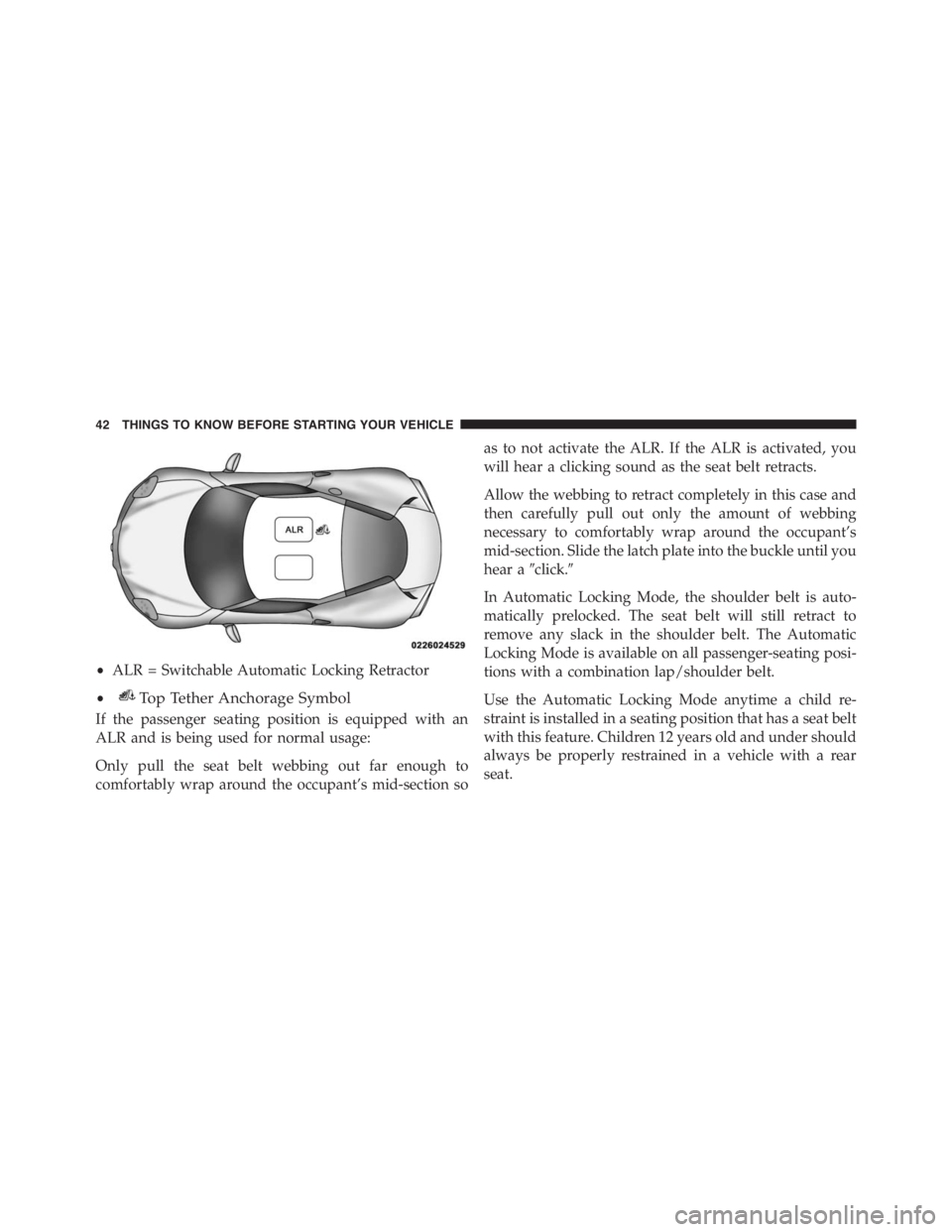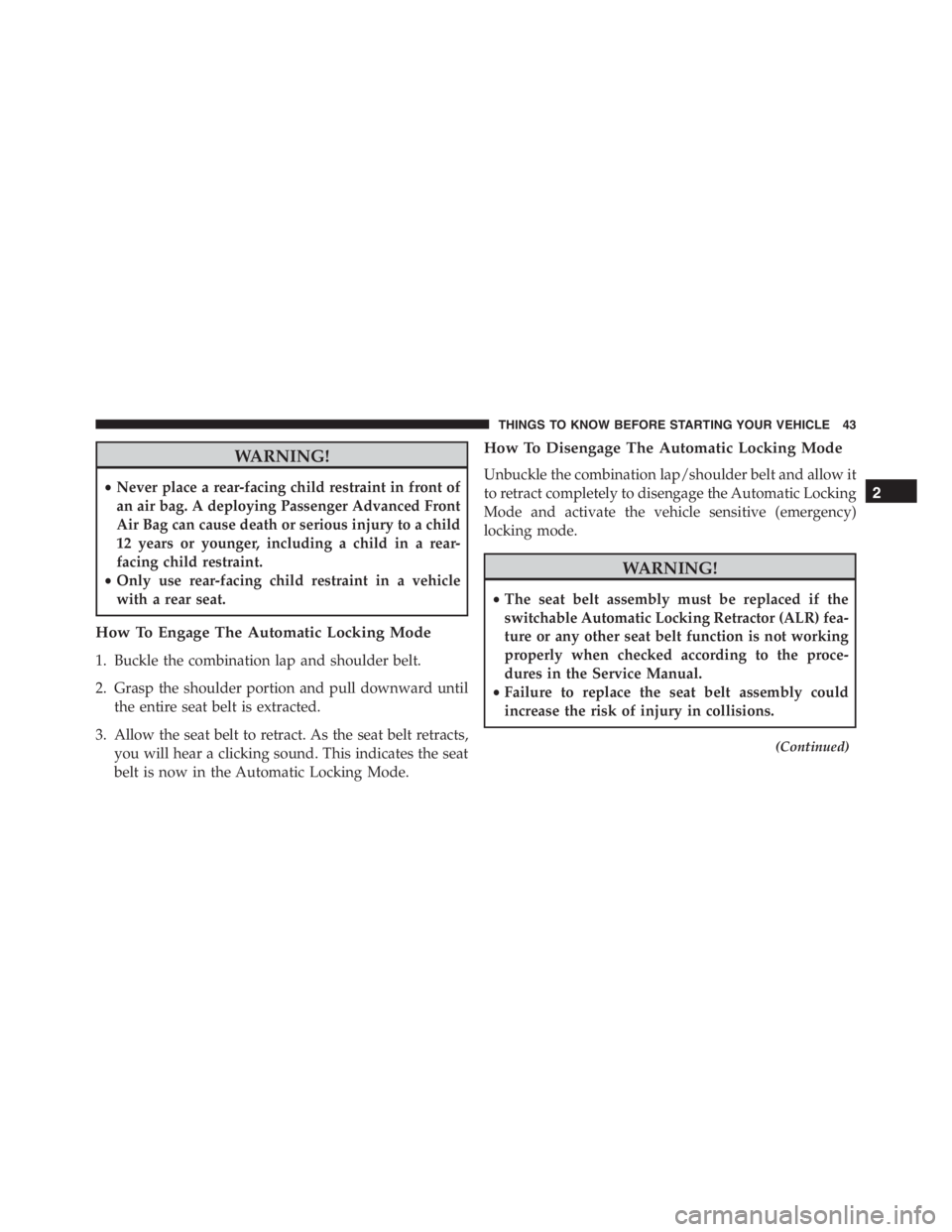Page 12 of 348
▫Central Door Locking/Unlocking...........23
▫Locking/Unlocking Doors From The Inside . . .25
▫Emergency Door Locking Device...........25
▫Door Opening/Closing Mechanism Reset.....26
�WINDOWS...........................27
▫Power Windows.......................27
�DECKLID.............................29
�OCCUPANT RESTRAINT SYSTEMS..........32
▫Seat Belt Systems......................33
▫Supplemental Restraint System (SRS)........44▫Child Restraints.......................57
�ENGINE BREAK-IN RECOMMENDATIONS....68
�SAFETY TIPS..........................69
▫Transporting Passengers.................69
▫Exhaust Gas.........................70
▫Safety Checks You Should Make Inside The
Vehicle.............................71
▫Periodic Safety Checks You Should Make Outside
The Vehicle..........................72
10 THINGS TO KNOW BEFORE STARTING YOUR VEHICLE
Page 14 of 348
3. Remove the key from the ignition switch lock cylinder.WARNING!
•Before exiting the vehicle, always apply the park-
ing brake, and remove the Key Fob from the
ignition. When leaving the vehicle, always lock
your vehicle.
•Never leave children alone in a vehicle, or with
access to an unlocked vehicle.
•Allowing children to be in a vehicle unattended is
dangerous for a number of reasons. A child or
others could be seriously or fatally injured. Chil-
dren should be warned not to touch the parking
brake, brake pedal or the transmission gear selec-
tor.
•Do not leave the Key Fob in or near the vehicle, or
in a location accessible to children. A child could
operate power windows, other controls, or move
the vehicle.
(Continued)
Ignition Switch Positions
1 — STOP (OFF/LOCK)
2 — MAR (ACC/ON/RUN)
3 — AVV (START) 12 THINGS TO KNOW BEFORE STARTING YOUR VEHICLE
Page 15 of 348

WARNING!(Continued)
•Do not leave children or animals inside parked
vehicles in hot weather. Interior heat build-up may
cause serious injury or death.
CAUTION!
An unlocked car is an invitation to thieves. Always
remove the key from the ignition and lock all the
doors when leaving the vehicle unattended.
Locking Doors With A Key
You can insert the key with either side up. To lock the
door, turn the key to the left. To unlock the door, turn the
key to the right. Refer to “Body Lubrication” in “Main-
taining Your Vehicle” for maintenance information.
Key-In-Ignition Reminder
Opening the driver’s door when the key is in the ignition
and the ignition switch position is OFF/LOCK, sounds a
signal to remove the key.
SENTRY KEY®
The Sentry Key® Immobilizer System prevents unau-
thorized vehicle operation by disabling the engine. The
system does not need to be armed or activated. Operation
is automatic, regardless of whether the vehicle is locked
or unlocked.
The system uses ignition keys which have an embedded
electronic chip (transponder) to prevent unauthorized
vehicle operation. Therefore, only keys that are pro-
grammed to the vehicle can be used to start and operate
the vehicle.
2
THINGS TO KNOW BEFORE STARTING YOUR VEHICLE 13
Page 26 of 348

The Door Lock LED Indicator buttonwill illuminate
to indicate that the doors have locked.
NOTE:Door locking is carried out with all doors shut.
Unlocking Doors From The Outside
Push the unlock button on the key or turn the metal
insert (located inside the key) in the driver side door lock.
WARNING!
•For personal security and safety in the event of a
collision, lock the vehicle doors before you drive as
well as when you park and leave the vehicle.
•Never leave children alone in a vehicle, or with
access to an unlocked vehicle. Allowing children to
be in a vehicle unattended is dangerous for a
number of reasons. A child or others could be
seriously or fatally injured. Children should be
warned not to touch the parking brake, brake pedal
or the transmission gear selector.
•Do not leave the Key Fob in or near the vehicle, or
in a location accessible to children. A child could
operate power windows, other controls, or move
the vehicle.
Door Lock LED Indicator
24 THINGS TO KNOW BEFORE STARTING YOUR VEHICLE
Page 43 of 348

Seat Belt Pretensioner
The front seat belt system is equipped with pretensioning
devices that are designed to remove slack from the seat
belt in the event of a collision. These devices may
improve the performance of the seat belt by removing
slack from the seat belt early in a collision. Pretensioners
work for all size occupants, including those in child
restraints.
NOTE:These devices are not a substitute for proper seat
belt placement by the occupant. The seat belt still must be
worn snugly and positioned properly.
The pretensioners are triggered by the Occupant Re-
straint Controller (ORC). Like the air bags, the preten-
sioners are single use items. A deployed pretensioner or
a deployed air bag must be replaced immediately.
Energy Management Feature
This vehicle has a seat belt system with an Energy
Management feature in the front seating positions that
may help further reduce the risk of injury in the event of
a collision. This seat belt system has a retractor assembly
that is designed to release webbing in a controlled
manner.
Automatic Locking Retractor Mode (ALR)
The seat belt in the passenger seating position is
equipped with a switchable Automatic Locking Retractor
(ALR) which is used to secure a child restraint system.
For additional information, refer to “Child Restraints” in
“Things To Know Before Starting Your Vehicle.” The
image below defines the type of feature for each seating
position.
2
THINGS TO KNOW BEFORE STARTING YOUR VEHICLE 41
Page 44 of 348

If the passenger seating position is equipped with an
ALR and is being used for normal usage:
Only pull the seat belt webbing out far enough to
comfortably wrap around the occupant’s mid-section soas to not activate the ALR. If the ALR is activated, you
will hear a clicking sound as the seat belt retracts.
Allow the webbing to retract completely in this case and
then carefully pull out only the amount of webbing
necessary to comfortably wrap around the occupant’s
mid-section. Slide the latch plate into the buckle until you
hear a�click.�
In Automatic Locking Mode, the shoulder belt is auto-
matically prelocked. The seat belt will still retract to
remove any slack in the shoulder belt. The Automatic
Locking Mode is available on all passenger-seating posi-
tions with a combination lap/shoulder belt.
Use the Automatic Locking Mode anytime a child re-
straint is installed in a seating position that has a seat belt
with this feature. Children 12 years old and under should
always be properly restrained in a vehicle with a rear
seat.
•ALR = Switchable Automatic Locking Retractor
•
Top Tether Anchorage Symbol
42 THINGS TO KNOW BEFORE STARTING YOUR VEHICLE
Page 45 of 348

WARNING!
•Never place a rear-facing child restraint in front of
an air bag. A deploying Passenger Advanced Front
Air Bag can cause death or serious injury to a child
12 years or younger, including a child in a rear-
facing child restraint.
•Only use rear-facing child restraint in a vehicle
with a rear seat.
How To Engage The Automatic Locking Mode
1. Buckle the combination lap and shoulder belt.
2. Grasp the shoulder portion and pull downward until
the entire seat belt is extracted.
3. Allow the seat belt to retract. As the seat belt retracts,
you will hear a clicking sound. This indicates the seat
belt is now in the Automatic Locking Mode.
How To Disengage The Automatic Locking Mode
Unbuckle the combination lap/shoulder belt and allow it
to retract completely to disengage the Automatic Locking
Mode and activate the vehicle sensitive (emergency)
locking mode.
WARNING!
•The seat belt assembly must be replaced if the
switchable Automatic Locking Retractor (ALR) fea-
ture or any other seat belt function is not working
properly when checked according to the proce-
dures in the Service Manual.
•Failure to replace the seat belt assembly could
increase the risk of injury in collisions.
(Continued)
2
THINGS TO KNOW BEFORE STARTING YOUR VEHICLE 43
Page 46 of 348

WARNING!(Continued)
•Do not use the Automatic Locking Mode to restrain
occupants who are wearing the seat belt or children
who are using booster seats. The locked mode is
only used to install rear-facing or forward-facing
child restraints that have a harness for restraining
the child.
Supplemental Restraint System (SRS)
Air Bag System Components
Your vehicle may be equipped with the following air bag
system components:
•Occupant Restraint Controller (ORC)
•Air Bag Warning Light
•Steering Wheel and Column
•Instrument Panel•Knee Impact Bolsters
•Advanced Front Air Bags
•Supplemental Side Air Bags
•Supplemental Driver Knee Air Bag
•Front and Side Impact Sensors
•Front Seat Belt Pretensioners, Seat Belt Buckle Switch,
and Seat Track Position Sensors
Advanced Front Air Bags
This vehicle has Advanced Front Air Bags for both the
driver and front passenger as a supplement to the seat
belt restraint systems. The driver’s Advanced Front Air
Bag is mounted in the center of the steering wheel. The
passenger’s Advanced Front Air Bag is mounted in the
instrument panel. The words AIRBAG are embossed on
the air bag covers.
44 THINGS TO KNOW BEFORE STARTING YOUR VEHICLE